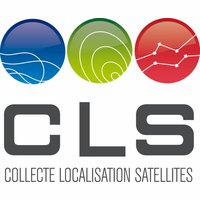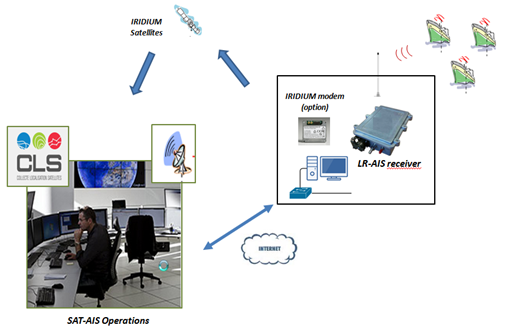
Objectives of the service
The objective of the AMTRACK2 is to provide to the maritime users that suffer the very low performances of SAT-AIS on high ship density areas or on the limitation of terrestrial AIS with an original, relevant and complementary source of AIS data provision. Indeed, the SAT-AIS is limited by the AIS message collision phenomena due to the fact that the satellite footprint includes a huge number of individual cells of 25-30 nautical miles that are not synchronized one with to the other. Consequently, not all of the message received from the satellite can be properly decoded. From the user point of view, a main issue which is regularly reported to CLS as an AIS data provider is that the TUI (Time Update Interval) of their vessels are, on areas of high ship densities, very bad and frequently of several hours. The update service will solve that problem thanks to an AIS receiver that will take benefit of enhanced capabilities of detection by a factor o 3 or more in range. The service will be primarily given in strategic coastal maritime areas like Asia but also on large offshore areas while embarking such equipment onboard supply vessels.
Users and their needs
The users may be institutional entities or private entities. In case of institutions, they are maritime traffic and/or security administrations like National authorities, coastguards or port authorities. Private companies are related to the operations of AIS coastal stations but also those involved in traffic control and monitoring, industrial domain like shipping, offshore activities, fishing or leisure activities. The military domain is also potentially on the fields of the applications.
The main user needs are as follows:
- to update existing AIS sites capabilities to significantly improve the data collection service on ship detection,
- to improve the AIS (Terrestrial and satellite AIS) service for specific analysis (ship behaviour, cross-check the EO data, navigation rules control…),
- to improve the SAR operations with longer AIS range (class B, MOB, EPRIB), potentially from aircraft, helicopters and from rescue ships
- to provide permanent or limited in time redundancy to an existing AIS site and to improve service reliability,
- to provide relevant AIS data collection service at reasonable cost on remote areas.
The two operational challenges to meet these needs are the filling the previously mentioned Sat-AIS and terrestrial AIS gaps especially in the areas of user interest.
Concerned countries of the targeted users are Europe, Asia, America…
Service/ system concept
The main components of the AMTRACK system are presented hereafter.
On-site
The LR-AIS (Long Range) prototype receiver (electronic device, antenna, cables for the connexion, power supply...) equipped with specifically designed signal processing algorithms to process messages collisions and weak signals,
- A computer and data storage system,
- An internet connexion,
- An Iridium modem,
At CLS premises, Toulouse, France
- The SAT-AIS and Terr-AIS data centres.

Figure - LR-AIS receiver connected to CLS SAT-AIS service
The users will take advantage of this new LR-AIS service in different ways as described hereafter:
- buying LR-AIS equipment (HW+SW) and in-situ data collection service (with adequate filtering and appropriate data formatting),
- subscribing to the LR-AIS service via the CLS AIS data center,
- buying AIS added value sales (including LR-AIS and other CLS products),
- buying CLS a LR-AIS private network management and associated service.
Space Added Value
One important key point of the service for the user is a quick access to the decoded AIS messages. That may be difficult in remote zones like open ocean or blank communication areas. In case of a LR-AIS receiver installed onboard a vessel an autonomous communication system and ideally later on integrated in the equipment is a satellite communication system. In order to optimize the data transmission and associated cost, a filtering of the output AIS data streaming is implemented according to the user requirements.
During the feasibility study, opportunities to have the LR-AIS prototype flying on a LEO satellite, including the ISS, will be analysed. It may be the complete set of SW and HW or only algorithms updating an existing programmable SDR. International collaboration will be envisaged for such a satellite service demonstration campaign.
Current Status
The LR-AIS receiver prototype has been developed and tested on the coast in South of France. Some technical difficulties have been faced on properly processing very strong signals (nearby ships) and very low signals (far ships). Therefore planned demonstrations in the framework of the Proof of Concept were cancelled and the feasibility study concluded with technical feasibility not proven.
Despite the experienced technical difficulties CLS is convinced of the technical concept plans to investigate this further outside the feasibility study. An improved version of the equipment prototype is envisaged.



